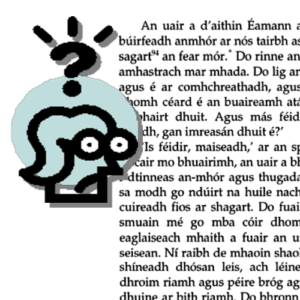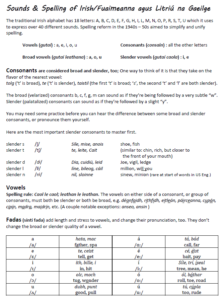In 2014, I gave a presentation at an Irish language weekend on how to pronounce words in Irish when you see them written. I walked them through a handout that covered some key concepts. When I was done, the group asked me if I could record what I had just said. A few months later I did that, and posted the video on YouTube as “Sounds and Spelling of Irish”
The video is based on that initial handout. Since then, I’ve updated the handout several times. This PDF is the latest version of the handout, from 2020.

Doing this was important to me because I initially gave up trying to learn Irish when I couldn’t figure out how to say the words (it was before the internet and all I had was a book written for speakers of British English). Years later I watched with amazement as the talented Irish educator Ray Mac Mánais taught the basics of Irish pronunciation to a class in Milwaukee in just a few minutes, giving people a usable foundation for reading written Irish.
The handout presents:

- Broad and slender
- Consonants – not all of them, but ones that differ greatly between broad and slender
- Vowels
- How the fada changes vowel pronunciation – I have read explanations that say it’s purely a difference in length, but that isn’t how it sounds to me. (e.g., mol vs. ól)
- Vowel combinations, which I group into most consistent and less consistent
- Syllable stress
- Initial mutations
- Séimhiú (aka lenition or aspiration) with examples for each consonant, in broad and slender contexts
- Urú (aka nasaliztion or eclipsis) with examples for each consonant, in broad and slender contexts
I hope you find these resources useful. I plan to produce additional videos that offer more targeted practice.
(The handout no longer matches the video exactly. The video has “úrú” for “urú” throughout. And when I made the video I didn’t know about contexts where ‘r’ is broad despite adjacent slender vowels.)
